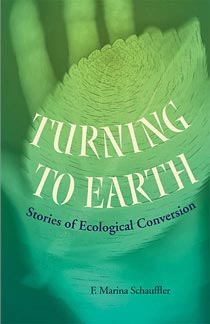
Inescapable: Facing up to Forever Chemicals (due out in March 2026)
My second book, currently in production, portrays one state’s response to the far-reaching impacts of PFAS (per- and polyfluoroalkyl substances), a class of chemicals in widespread use despite their damaging effects on human and natural communities. Look for details here as the publication date approaches.
Turning to Earth: Stories of Ecological Conversion

–Thomas Moore, author of Care of the Soul
–David W. Orr, author of The Nature of Design
Turning to Earth offers a window into the heart of environmental change, moving beyond the culture’s traditional reliance on policy reforms and technological measures. It charts the course of “ecological conversion,” a dynamic inner process by which people come to ally themselves with the natural world and speak out on its behalf. Stories by ecological converts illuminate a critical realm long neglected by environmental scholars and activists–how the terrain of spirit, psyche and conscience shape our commitment to Earth.
This engaging exploration of “inner ecology” deftly weaves together numerous autobiographical accounts with insights from the fields of ecocriticism, ecopsychology, environmental philosophy and environmental education. An opening portrait of writer and activist Terry Tempest Williams traces her deepening devotion to Earth. Each subsequent chapter explores a key element of ecological conversion, drawing primarily on the personal testimony of Williams and five other pioneering writers–Rachel Carson, Alice Walker, Edward Abbey, Scott Russell Sanders and N. Scott Momaday. Turning to Earth extends the parameters of contemporary environmental discussion by illustrating how substantive change hinges not just on political and institutional reforms but on profound inner transformation. The compelling life narratives of ecological converts provide inspiration and direction for the growing number of activists, educators, scholars and citizens who are committed to changing the world from the inside out.
Turning to Earth appeals to a wide range of readers, including
- scholars and students in religion, literature, philosophy, psychology and environmental studies;
- general readers;
- environmental educators and activists;
- spiritual practitioners and faith communities;
- conservationists;
- and outdoor enthusiasts.
It is both a practical and inspirational text, offering ‘teaching stories’ that can transform perception and practice. Turning to Earth is well-suited for use in book discussion groups, undergraduate and graduate courses, and church study/religious youth groups (with high school age participants).
Table of Contents
Bedrock, the opening chapter, explores the ecological conversion of writer Terry Tempest Williams–demonstrating how key elements of the process manifest in one individual’s life story. A fifth-generation Mormon, Williams is devoted to her extended family and her home terrain in Utah. These bonds have shaped the path of her ecological turning through childhood experiences outdoors; familial mentors; revelatory encounters in the natural world; and a growing commitment to “re-story” the land through narrative and defend it through local activism. The detailed profile of Williams’s turn sets the context for subsequent chapters, each of which synthesizes material from numerous writers around a unifying theme.
Remembrance, the second chapter, cites commonalities in the formative experiences of the primary writers – all of whom shared a strong affinity for the natural world as children, found support for this bond through mentors, and gained inspiration from the words and lives of established nature writers. The marked parallels in their experience suggest that contact with the natural world and with mentors (both familial and literary) may set the stage for a subsequent turn to Earth.
Reflection, the third chapter, describes how periods of enforced introspection lead converts to reassess their place in the ecological whole. Times of psychic transformation can occur in response to experiences of loss, illness, estrangement or despair, as well as deliberate immersion in natural settings. While reflective periods can prove emotionally taxing, they may awaken a sense of compassion that deepens an ecological practice.
Revelation, the fourth chapter, illustrates how converts experience moments of insight that renew and reconstitute their lives. These profound glimpses into a larger mystery often affirm their sense of belonging to a sacred whole. Revelatory experiences can inspire fundamental changes in ecological belief and practice.
Reciprocity, the fifth chapter, demonstrates how converts consciously strengthen their identification with other members of the ecological community. Writers often cultivate empathic modes of relation, seeking to counter the cultural taboos and engrained fears that separate humans from the rest of nature. A recognition of reciprocity often fosters a stronger commitment to the ecological whole.
Resistance, the sixth chapter, discusses how ecological converts–motivated by their deep affinity for the natural world–devote themselves to responsible action on its behalf. Some bear witness to environmental degradation primarily through writing; others take direct action through ecological restoration, land conservation, or civil disobedience. Their actions testify to a deepening bond with Earth.
Ritual, the seventh chapter, portrays how creative and ritual arts support the conversion process. Through writing and sharing narratives and performing ceremonial rites, writers often affirm their sense of belonging within nature. Imaginative and sacred rituals become a means of simultaneously celebrating and reinforcing connections within the ecological community.

